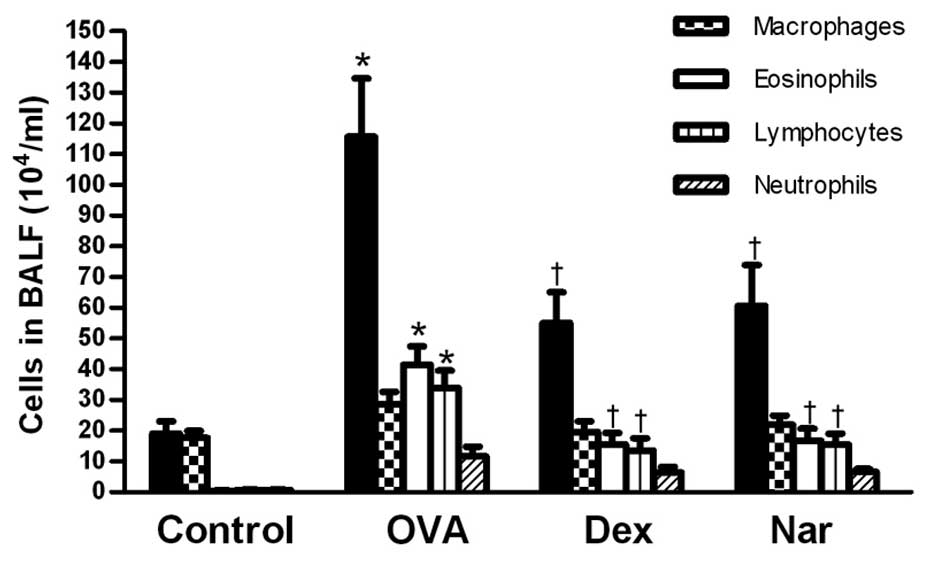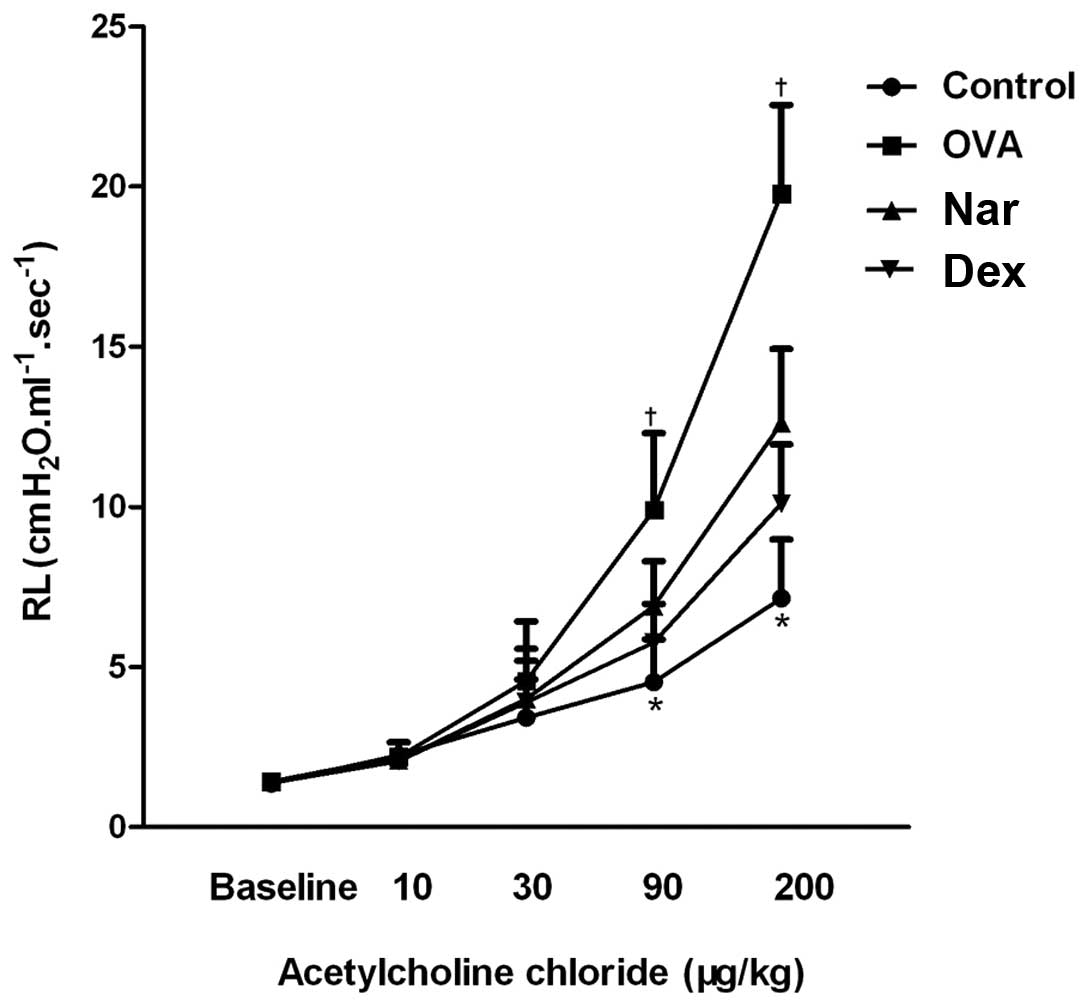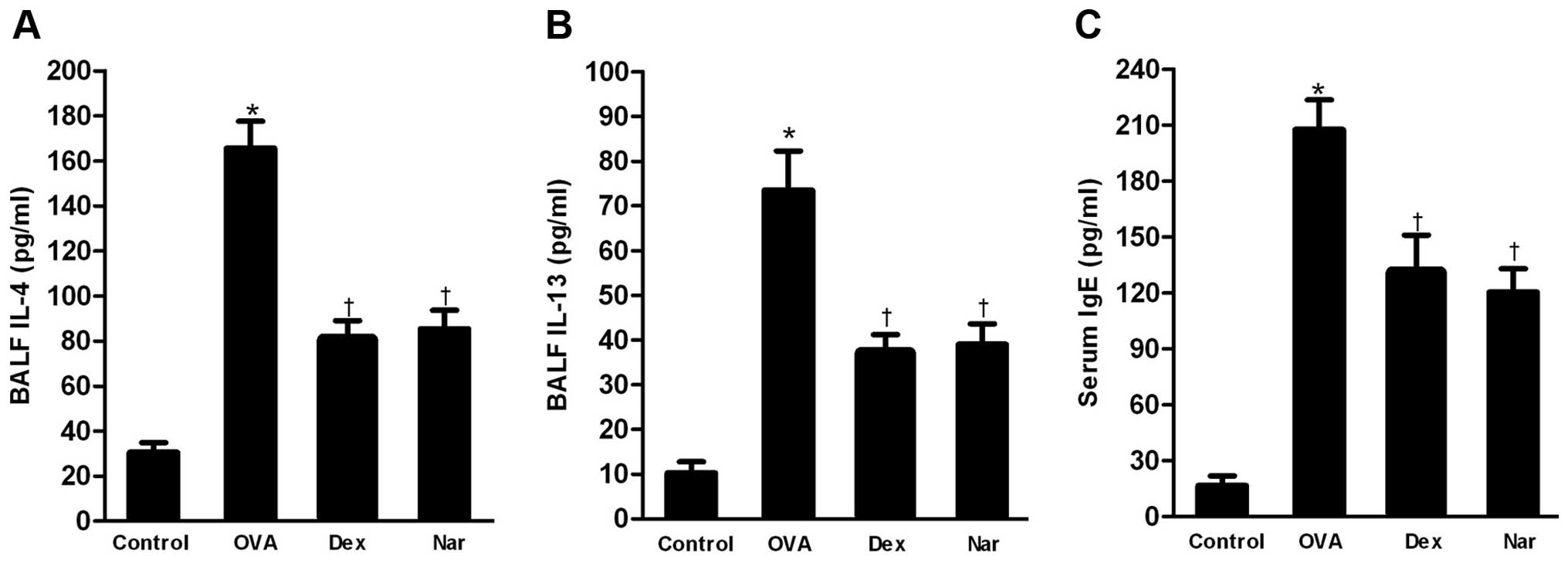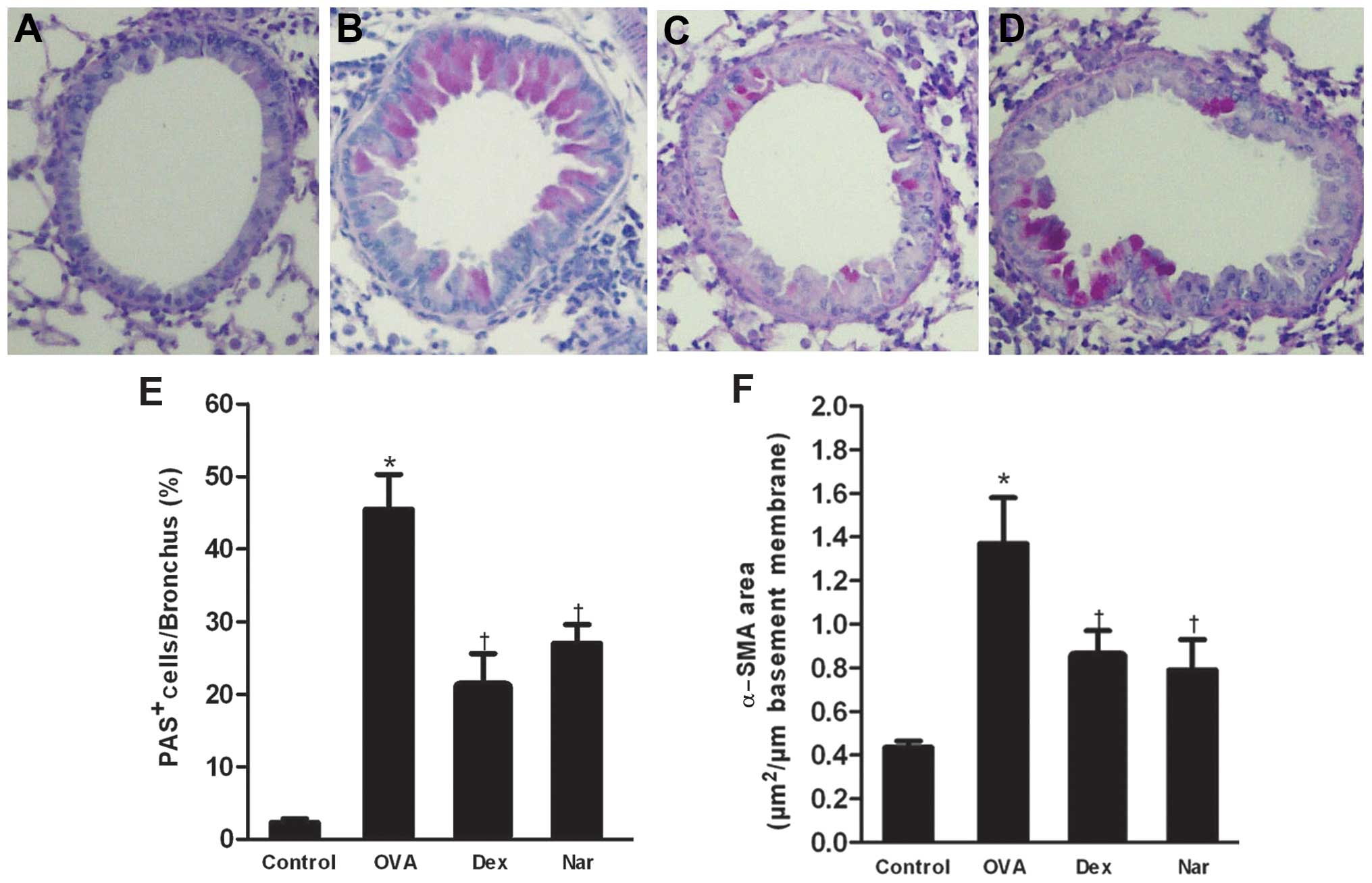Naringenin inhibits allergen‑induced airway remodeling in a murine model of asthma
- Authors:
- Published online on: February 10, 2014 https://doi.org/10.3892/mmr.2014.1940
- Pages: 1204-1208
Abstract
Introduction
Bronchial asthma is an allergic disease manifesting with symptoms such as wheezing, breathlessness, chest tightness and coughing (1). Cardinal features of the disease are airway hyper-responsiveness (AHR), inflammation and remodeling (2). Airway remodeling refers to structural changes of the airway wall arising from unresolved inflammation, including epithelial denudation, subepithelial fibrosis, mucus gland hypertrophy, myofibroblast and smooth muscle proliferation and angiogenesis (3–5). These structural changes play important roles in the pathophysiology of asthma. In patients with severe asthma, airway remodeling is associated with airway thickening, airway flow limitation and AHR (6).
Naringenin is a naturally occurring flavonoid possessing anti-inflammatory and antiproliferative activities (7,8). We have previously demonstrated that naringenin attenuates acute inflammation and AHR in allergen-induced murine models of asthma (9). There are also reports that naringenin can inhibit neointimal hyperplasia and smooth muscle cell proliferation (10,11). Therefore, we hypothesized that naringenin may interfere with the structural changes occurring in chronic airway diseases. In the present study, we investigated the effects of naringenin on airway remodeling in a murine model of asthma.
Materials and methods
Antigen sensitization, challenge and naringenin treatment
Female BALB/c mice (6–8 weeks old) were purchased from the Shanghai Laboratory Animal, Inc. (Shanghai, China). The experimental procedures involving these mice were approved by the Nanjing Medical University and followed the guidelines of the Institutional Animal Care and Use Committee. Naringenin (Sigma-Aldrich, St. Louis, MO, USA) was dissolved in dimethylsulfoxide to obtain a final concentration of 0.1 mg/μl (367 mM), used as the stock solution.
Mice were randomly divided into four groups according to the difference of antigen in sensitization and treatment before challenge, namely control group, ovalbumin (OVA) group, dexamethasone group and naringenin group. Dexamethasone was purchased from Tianyao Company (Hubei, China) and was used at a concentration of 1 mg/ml. On days 0, 7 and 14, mice of the OVA, dexamethasone and naringenin groups were immunosensitized by intraperitoneal injection of 100 μg chicken egg OVA (grade V; Sigma-Aldrich) adsorbed to 100 μl of Imject Alum adjuvant (Pierce Biotechnology, Inc., Rockford, IL, USA). From day 21, the mice were challenged with 1% OVA aerosolized for 30 min/day, 3 days/week for 8 weeks. Mice of the dexamethasone and naringenin groups received intraperitoneal injections of dexamethasone (5 mg/kg body weight) and naringenin (50 mg/kg body weight) 1 h prior to each OVA challenge. The dose of naringenin was selected based on our previous study (9). Mice of the negative control group were sham-sensitized and -challenged using phosphate-buffered saline (PBS).
Airway physiology
Airway responsiveness was measured 24 h after the last OVA challenge. The mice were anesthetized, tracheostomized and placed in a whole-body plethysmograph (Synol High-Tech, Beijing, China). Then, mice were ventilated via an intratracheal tube at 90 breaths/min. Methacholine was administered through the caudal vein. The maximal values of lung resistance were measured after the administration of increasing doses of methacholine (10–200 μg/kg).
Analysis of bronchoalveolar lavage fluid (BALF) and serum
The airway lumina were washed 3 times with 0.5 ml of PBS. The BALF was centrifuged and the upper fluid sample was retained for IL-4 and IL-13 detection. The total number of different cell types in the BALF was estimated using Wright’s staining and a haemocytometer; at least 200 cells were counted. Serum IgE levels were measured with the OptEIA™ ELISA kit (BD Biosciences, San Diego, CA, USA).
Lung histology and periodic acid schiff (PAS) staining
The left lungs, collected 24 h after the last OVA challenge, were fixed in formalin, embedded in paraffin, sectioned and stained with hematoxylin and eosin solution and PAS. Blind-scoring histological analyses of the four groups was performed by pathologists. To quantify the mucus production in the airways, the number of PAS-negative and -positive epithelial cells (goblet cells) in individual bronchioles was counted as previously described (12). The percentage of PAS-positive cells was calculated as the number of PAS-positive epithelial cells per bronchiole divided by the total number of epithelial cells.
Immunohistochemical detection of α-smooth muscle actin (α-SMA)
Sections were deparaffinized and rehydrated in graduated alcohol solutions. Endogenous peroxidase activity was blocked by incubation with 3% H2O2. Specimens were flooded with 5% normal goat serum to prevent non-specific absorption of immunoglobulin. Specimens were then incubated with mouse anti-human α-SMA moloclonal antibody (Dako, Glostrup, Denmark). For the negative control, the primary antibody was replaced with normal rabbit IgG. The slides were incubated overnight and rinsed with PBS, then incubated with peroxidase-labeled goat anti-mouse IgG (Dako) for 30 min at 37°C, washed again with PBS, and stained with diaminobenzidine (Santa Cruz Biotechnology, Inc., Santa Cruz, CA, USA). The sections were counterstained with hematoxylin and eosin, dehydrated and observed under a light microscope. At least 10 bronchioles were counted in each of the slides. Data were expressed as the immunostained α-SMA area per length of the basement membrane of bronchioles (internal diameter, 150–200 μm2).
Assessment of peribronchial fibrosis
The total collagen content of the lung was determined according to the protocol of a commercial hydroxyproline detection kit (Nanjing Jiancheng Bioengineering Institute, Nanjing, China). The peribronchial area was stained with Masson’s trichrome staining and quantified using a light microscope attached to an image-analysis system (Simple PCI, version 5.2; Leica, Mannheim, Germany). At least 10 bronchioles were counted in each of the slides. Data were expressed as the stained area per length of the basement membrane of bronchioles.
Statistical analysis
Data were presented as means ± SEM. Statistical comparisons were performed with one-way ANOVA using the SPSS 16.0 software (IBM SPSS Statistics, Armonk, NY, USA). P<0.05 was considered to indicate a statistically significant difference.
Results
Naringenin attenuates chronic airway inflammation
Marked influxes of inflammatory cells into the airway and around the blood vessels were observed in the OVA-sensitized and -challenged mice, but not in the control mice. Mice treated with naringenin and dexamethasone showed marked reductions in the infiltration of inflammatory cells compared to the OVA-treated group (Fig. 1).
Following sensitization and challenge with OVA, the number of total leukocytes, eosinophils and lymphocytes were significantly increased compared to those of the control mice. Treatment with naringenin and dexamethasone significantly reduced the number of eosinophils and total inflammatory cells in the BALF (Fig. 2).
Naringenin decreases AHR in a model of chronic asthma
OVA treatment resulted in a marked increase in lung resistance values relative to those of the control group. This increase was reverted by treatment with dexamethasone and naringenin, especially at the 90 and 200 μg/kg methacholine doses (Fig. 3).
Naringenin reduces the level of T helper 2 (Th2) cytokines in BALF and that of total serum IgE
The levels of Th2 cytokines IL-4 and IL-13 in BALF and that of total serum IgE were markedly increased in the OVA-sensitized and -challenged mice compared to those in the control group. The administration of naringenin and dexamethasone significantly reduced the levels of Th2 cytokines (Fig. 4A and B) in BALF and total serum IgE (Fig. 4C) relative to those in the OVA group.
Naringenin inhibits airway remodeling in a model of chronic asthma
The level of airway metaplasia and mucus production was assessed by PAS staining of lung tissues and the percentage of PAS-positive cells was determined. Overproduction of mucus and goblet cell hyperplasia were observed in the bronchial airways of mice in the OVA group. By contrast, dexamethasone- and naringenin-treated mice showed a reduction in the number of PAS-stained goblet cells (Fig. 5).
The areas of α-SMA-stained smooth muscle layers in OVA mice were significantly larger compared to control mice. Administration of naringenin and dexamethasone reduced the areas of α-SMA compared to the OVA group (Figs. 5F and 6).
Masson’s trichrome staining revealed collagen deposition (fibrosis). The mean area of airway fibrosis in the OVA group was markedly enhanced compared to the control group. Administration of naringenin and dexamethasone caused a reduction in collagen deposition compared to the OVA group (Fig. 7A–E). The total hydroxyproline content in lungs of the OVA group was significantly higher compared to that of the control group. Treatment with naringenin and dexamethasone reduced the hydroxyproline content compared to the OVA group (Fig. 7F).
Discussion
A previous study showed that naringenin, a naturally occurring flavonoid, attenuates acute airway inflammation and AHR, in association with NF-κB repression and reduced cytokine production (9). Consequently, we evaluated the effect of naringenin on airway remodeling using a long-term exposure murine model of asthma. The results of our study clearly demonstrate the inhibitory effect of naringenin on airway remodeling.
Sensitization and chronic challenge of mice with OVA resulted in inflammation of the airway, evidenced here by the recruitment of inflammatory cells, the production of Th2 cytokines and an increase in the total IgE level. The inflammation was effectively attenuated by naringenin treatment. As a natural anti-inflammatory flavonoid, naringenin displayed anti-inflammatory action in a long-term asthmatic process.
Marked goblet cell hyperplasia and mucus hypersecretion were previously observed in the small airway under chronic airway inflammatory conditions (13), consistent with results on our murine model of asthma. In this study, we demonstrated that naringenin significantly reduced the number of mucus-producing goblet cells within the epithelium after OVA challenge. It has been shown that IL-4 and IL-13 induce goblet cell hyperplasia in the lungs of mice (14,15). Therefore, the ability of naringenin to reduce mucus production in chronic asthma might relate to its inhibitory effect on Th2 cytokine production.
Another important aspect of airway remodeling is airway smooth muscle (ASM) hyperplasia, which has been linked to the severity of asthma (16). Consistent with previous reports, the areas of α-SMA were significantly increased after exposure to OVA in our animal model, while ASM hyperplasia was greatly reduced by treatment with naringenin In addition, we found that airway resistance was reduced following naringenin treatment. Since ASM contributes to airway narrowing and AHR in response to a variety of stimuli during asthma, we hypothesize that the ability of naringenin to reduce the thickness of the ASM layer may partially account for the observed decrease in AHR.
Collagen deposition in the airways is also associated with a decrease in lung function and with the severity of asthma in humans. We demonstrated for the first time that naringenin significantly inhibits the deposition of subepithelial collagen in a chronic asthma model. In the asthmatic process, epithelial damage and subsequent Th2-mediated inflammation are expected to cause an increase in the production of a few potent profibrotic cytokines, such as transforming growth factor β and tissue inhibitors of metalloproteinases (17,18). Therefore, we assume that the naringenin-mediated reduction in the Th2 cytokine levels may account for the anti-fibrotic activity of naringenin through inhibition of the production of profibrotic cytokines.
Additional mechanisms by which naringenin may modulate airway remodeling exist. Naringenin is a naturally occurring antioxidant (19). Oxidative stress is closely linked to the pathogenesis of chronic airway disorders, such as the increase in microvascular permeability, excessive mucus secretion and remodeling of the extracellular matrix and blood vessels (20). Therefore, naringenin may prevent airway remodeling by reducing the production of reactive oxygen species.
In conclusion, we have shown that treatment with naringenin effectively inhibits allergen-induced airway inflammation and remodeling. The ability of naringenin to modulate chronic asthma pathology renders it a promising target for asthma therapy.
References
|
Bousquet J, Clark TJ, Hurd S, Khaltaev N, Lenfant C, O’Byrne P and Sheffer A: GINA guidelines on asthma and beyond. Allergy. 62:102–112. 2007. View Article : Google Scholar | |
|
Bousquet J, Jeffery PK, Busse WW, Johnson M and Vignola AM: Asthma. From bronchoconstriction to airways inflammation and remodeling. Am J Respir Crit Care Med. 161:1720–1745. 2000. View Article : Google Scholar : PubMed/NCBI | |
|
Vignola AM, Gagliardo R, Siena A, Chiappara G, Bonsignore MR, Bousquet J and Bonsignore G: Airway remodeling in the pathogenesis of asthma. Curr Allergy Asthma Rep. 1:108–115. 2001. View Article : Google Scholar | |
|
Tagaya E and Tamaoki J: Mechanisms of airway remodeling in asthma. Allergol Int. 56:331–340. 2007. View Article : Google Scholar : PubMed/NCBI | |
|
Warner SM and Knight DA: Airway modeling and remodeling in the pathogenesis of asthma. Curr Opin Allergy Clin Immunol. 8:44–48. 2008. View Article : Google Scholar : PubMed/NCBI | |
|
Benayoun L and Pretolani M: Airway remodeling in asthma: mechanisms and therapeutic perspectives. Med Sci (Paris). 19:319–326. 2003.(In French). | |
|
Park HY, Kim GY and Choi YH: Naringenin attenuates the release of pro-inflammatory mediators from lipopolysaccharide-stimulated BV2 microglia by inactivating nuclear factor-κB and inhibiting mitogen-activated protein kinases. Int J Mol Med. 30:204–210. 2012.PubMed/NCBI | |
|
Anand K, Sarkar A, Kumar A, et al: Combinatorial antitumor effect of naringenin and curcumin elicit angioinhibitory activities in vivo. Nutr Cancer. 64:714–724. 2012. View Article : Google Scholar : PubMed/NCBI | |
|
Shi Y, Dai J, Liu H, et al: Naringenin inhibits allergen-induced airway inflammation and airway responsiveness and inhibits NF-κB activity in a murine model of asthma. Can J Physiol Pharmacol. 87:729–735. 2009.PubMed/NCBI | |
|
Cayci C, Wahlquist TC, Seckin SI, et al: Naringenin inhibits neointimal hyperplasia following arterial reconstruction with interpositional vein graft. Ann Plast Surg. 64:105–113. 2010. View Article : Google Scholar : PubMed/NCBI | |
|
Chen S, Ding Y, Tao W, Zhang W, Liang T and Liu C: Naringenin inhibits TNF-α induced VSMC proliferation and migration via induction of HO-1. Food Chem Toxicol. 50:3025–3031. 2012. | |
|
Cho JY, Miller M, Baek KJ, et al: Inhibition of airway remodeling in IL-5-deficient mice. J Clin Invest. 113:551–560. 2004. View Article : Google Scholar : PubMed/NCBI | |
|
Rogers DF: Airway goblet cell hyperplasia in asthma: hypersecretory and anti-inflammatory? Clin Exp Allergy. 32:1124–1127. 2002. View Article : Google Scholar : PubMed/NCBI | |
|
Kuperman DA, Huang X, Koth LL, et al: Direct effects of interleukin-13 on epithelial cells cause airway hyperreactivity and mucus overproduction in asthma. Nat Med. 8:885–889. 2002.PubMed/NCBI | |
|
Kuperman DA, Huang X, Nguyenvu L, Holscher C, Brombacher F and Erle DJ: IL-4 receptor signaling in Clara cells is required for allergen-induced mucus production. J Immunol. 175:3746–3752. 2005. View Article : Google Scholar : PubMed/NCBI | |
|
Black JL, Panettieri RA Jr, Banerjee A and Berger P: Airway smooth muscle in asthma: just a target for bronchodilation? Clin Chest Med. 33:543–558. 2012. View Article : Google Scholar : PubMed/NCBI | |
|
Bosse Y and Rola-Pleszczynski M: Controversy surrounding the increased expression of TGFβ1 in asthma. Respir Res. 8:662007. | |
|
Mohamed SA, Noack F, Schoellermann K, et al: Elevation of matrix metalloproteinases in different areas of ascending aortic aneurysms in patients with bicuspid and tricuspid aortic valves. Scientific World Journal. 2012:8062612012. View Article : Google Scholar : PubMed/NCBI | |
|
Yang J, Li Q, Zhou XD, Kolosov VP and Perelman JM: Naringenin attenuates mucous hypersecretion by modulating reactive oxygen species production and inhibiting NF-κB activity via EGFR-PI3K-Akt/ERK MAPKinase signaling in human airway epithelial cells. Mol Cell Biochem. 351:29–40. 2011.PubMed/NCBI | |
|
de Boer WI, Yao H and Rahman I: Future therapeutic treatment of COPD: struggle between oxidants and cytokines. Int J Chron Obstruct Pulmon Dis. 2:205–228. 2007.PubMed/NCBI |

















